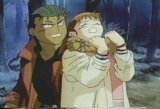

Quick Links:
Blue Seed
Blue Seed is an interesting attempt at mixing science and folklore / mythology in an almost believable way. Basically, all of the monsters of folk tales and the like are asserted to be some kind of psychically enhanced form of plant life, called aragami; then, the greater activity of such monsters at night follows from the greater energy release during the Dark Reaction. Similarly, the weakness of monsters under daylight is explained as the torpor from the shift to photosynthesis. Believability breaks down shortly afterwards, of course, starting with the assertion that some psychic energy is stored in the mitama, or "blue seeds"... but this is anime, ne? ^_^
At first glance to a gaijin, there may not seem to be too much more to the plot of Blue Seed, other than the side humor of the character interactions and the progressive exploration of the concept of the aragami, an explication which runs a fine line between the believable and the ludicrous. However, those familiar with Japanese history from the late Tokugawa period to modern times should find a number of strong symbols and statements about modern Japanese society and religion, especially near the end of the series. Students of the Meiji era should find basically every major theme from that time, from the ee ja nai ka riots or ikki to the relationship of Shinto to the government and the pitfalls of foreign affairs, touched upon at one point or another throughout the series, offering some provocative food for thought for a second viewing, in addition to the rampant side silliness (which boasts a hilarious "Omake Theater" every two episodes for those who didn’t get enough gags in the actual series). So, while the series may not have the most gripping plotline, the thematic richness can compensate for it if you have the right background.
The characters, on the other hand, are mostly standard stereotypes acting out fairly predictable roles. It doesn’t take too much thought to guess what a character will do at any given point after you’ve seen them for a bit (though you might be surprised at the number of different ways the animators found to reveal Momiji’s panties :P). At the same time, this choice of characterizations is somewhat on purpose, as you can see with a little thought at the end of the program: it is important to the overall theme that the "heroes" be everyday people. And, the character interactions provide a needed humor to temper the other themes of the show... and to break up the potential monotony of aragami slaying. Furthermore, there is a slow progression of character development, primarily focusing on the relationship between Momiji and Kusanagi. Unfortunately, just as the general character personality types are fairly stereotyped, the character development is fairly standard... and near the end gets rushed a bit in terms of the resolution of Kusanagi’s feelings.
There’s nothing impressive about the animation in this series. The lackluster CG in the introduction thankfully doesn’t plague the actual episodic animation, as what little CG is used within the episodes is actually fairly easily overlooked by the casual viewer. It’s a tv series, with that standard tv look, and not overly much detail placed into the background or animation. At the same time, though, I was never left feeling jilted after an episode, since there was plenty of variety and motion in the animation (then again, maybe I’m just in a state of denial, from watching too much anime lately ^_^;;).
The music for this series was... thematically appropriate, for the most part. Unfortunately, the opening song is a source of extreme pain for me, in spite of the Shinto melody that it was based on... I’m afraid it is one of those songs which personifies the problems with the emperor’s legalization of the "magic mushroom." Moving past that... problem... however, the rest of the music is reasonably well composed, fitting the mood of the scenes quite appropriately while still fitting into the overall "Shinto" theme. The closing song is not the most stunning example of Hayashibara Megumi’s singing, but it does fit well with the character of Momiji. Unfortunately, whatever merits the rest of the soundtrack might have cannot ultimately offset the hyper-aggressive tendencies now inspired in me when I hear the words "Mysterious Tokyo"... @_@
Blue Seed really has a lot going for it, with a reasonable mix of humor and a quite different thematic framework for an anime series. However, a lot of the depth of the series will be missed by the casual viewer, because so much of it depends on the context of the modernization of Japan, particularly the Meiji period. Without looking at the series from this perspective, the ending in particular will seem a trivial fit of hokeyness, which is quite ironic given the potential political and religious controversy it should inspire. I’d strongly recommend seeing it if you are familiar with the historical themes, but otherwise... the series becomes just a slightly different rehash of the same-old, same-old, with a silly deus ex machina ending.
Distributor: ADV Creator: Production IG, Ashi Production, Studio OX Released: 1994
Plot: B Character Design: B- Animation Quality: C Music: B Overall: B



